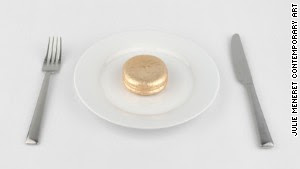We have read about this before and sure the tile and subject are humorous to some but the choco pie phenomenon is worth looking at from distribution on the black market to defiance of north Korean control to the influence of the Kaesong Industrial Complex.
V/R
Dave
How Choco Pie infiltrated North Korea's sweet tooth
By Madison Park, Frances Cha and Evelio Contreras, CNN
updated 3:18 AM EST, Mon January 27, 2014
STORY HIGHLIGHTS
- Businessman describes North Korean workers at Kaesong trying Choco Pie for first time
- Popularity of snack in North Korea shows how it could penetrate that country's society
- South Korean workers give cup noodles instead of Choco Pie
(CNN) -- The first time the South Korean factory owner watched his North Korean employees nibble on a Choco Pie, they appeared shocked -- even overwhelmed.
He summed up their reaction to the South Korean snack in one word: "Ecstasy."
Much like what Twinkies are to Americans, South Korea's Choco Pies -- two disc-shaped, chocolate-covered cakes, sandwiching a rubbery layer of marshmallow cream -- are ubiquitous, cost less than 50 cents and are full of empty calories.
But on the other side of the Korean border, the snacks are viewed as exotic, highly prized treats, selling on North Korea's black markets for as much as $10, according to analysts. Their rising popularity in the north reveals an unexpected common ground between the two Koreas, despite their fractious relationship -- a shared sweet tooth.
Artist Jin Joo Chae creates a golden Choco Pie.
This month, an art exhibition called "The Choco Pie-ization of North Korea" opened in New York, exploring the symbolism of the treat. The high value in North Korea of the Choco Pie, something considered so widespread and mundane in South Korea, is "a sad tragic story," said the artist, Jin Jo Chae.
Chae smeared melted chocolate across the North Korean newspaper Rodung Sinmun, staining the state-run propaganda with something sweet. She used the chocolate to make a symbol of Choco Pie, written in the lettering style of Coca Cola. Her exhibit, displayed at Julie Meneret Contemporary Art gallery, also contains piles of Choco Pies as well as a gold-plated one.
"Through this Choco Pie, I found the potential from chocolate as an object that changes a society," Chae said.
The Choco Pie represents something more than just a treat.
Subversive Choco and Coke?
Despite perceptions of North Koreans as brainwashed, insulated masses, the hunger and desire for Choco Pie shows that "complete quarantine is impossible," wrote Richard Lloyd Parry in London Review of Books. Lloyd wrote that it "reveals a susceptibility to outside influence in a society commonly regarded as impenetrable." The crumbly mass of chocolate and marshmallow had taken on a subversive aspect.
Indeed, Chae, the artist behind the exhibit, says, the Choco Pie "has a power in how it works as a mind changing tool between South and North."
Chocolate is smeared on top of North Korean-run state newspaper Rodung Sinmun.
The South Korean factory owner, who introduced his North Korean workers to Choco Pies, washed down with a Coca Cola, said the products seemed to leave an impression on his staff.
"It was clear that the workers had gotten at least some idea of capitalism and that it wasn't all bad," he told CNN.
"They had only associated the United States with evil, and the fact that they could love something that the U.S. had produced -- specifically Coca Cola -- was an eye-opener."
Choco trade
The factory owner, who did not wish to be named, operated his business for seven years at the Kaesong Industrial Complex, one of the key symbols of cooperation between North and South Korea, and the site through which Choco Pies trickled into North Korea.
At the complex, more than 100 South Korean factory owners employ about 50,000 North Korean laborers to manufacture products like clothing and shoes. Kaesong, considered to be an important source of hard currency for North Korean leader Kim Jong Un's regime, sits just a few kilometers north of the Demilitarized Zone, which divides the two Koreas. It re-opened in September after a five-month hiatus.
(Continued at the link below)



No comments:
Post a Comment